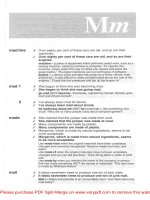Tài liệu TOEFL STUDY GUIDE PART 2 LISTENING COMPREHENSION docx
Bạn đang xem bản rút gọn của tài liệu. Xem và tải ngay bản đầy đủ của tài liệu tại đây (14.63 KB, 6 trang )
TOEFL STUDY GUIDE
PART 2
LISTENING COMPREHENSION
Test Design Features
Length: 40-60 minutes (15-25 minutes are actually for response
time; the time spent listening to the stimuli is not counted).
Number of Questions: 30-50 questions
m Dialogues: 11 - 17 with 1 item each
m Short conversations: 2 - 3 sets with 2-3 questions per set
m Mini-lectures/academic discussions: up to 2.5 minutes in
length, 4 -6 sets with 3 - 6 questions per set.
Headphones with adjustable volume control
Examinees will both see and hear the questions before the answer
choices appear.
This section is computer-adaptive.
Types of Listening Material
Dialogues and short conversations (traditional multiple-choice
questions only)
Segments of classroom lectures on academic topics (traditional and
new question types)
Segments of academic discussions on academic topics involving
multiple speakers (traditional and new question types)
Types of Listening Questions
Mostly traditional multiple-choice questions (1 stem and 4 options)
Some new question types that are not single-selection multiple
choice:
m Clicking on a picture or parts of a picture: not very different
from traditional multiple-choice
m Clicking on two choices: testing main reasons or supporting
details; similar to traditional multiple choice but with two
correct answers (usually four options total)
Matching/ordering objects or text: testing comprehension of a
process, understanding of a categorization of groups.
We do not specify that a certain number of these types of questions
be used; one type is not necessarily more difficult than the others;
each type can range from easy to difficult.
Use of visuals
Can take advantage of the multimedia capability of the computer by
using photos and graphics to create context and support the content
of the lectures, and more closely approximate "real world" situations
(in which we don't just listen to voices).
Use of visuals in two ways:
1. Context - photos of the speaker or speakers that provide
setting for the stimulus (e.g., photos of lecturer, photo of
speakers conversing); every set has a context-setting visual.
2. Content - reinforces what the stimulus is about; visuals are
authentic to lectures (e.g., diagram of a cell or key terms from
lecture written on the board); half of the sets in the pool have
a content-related visual; the visuals are used only if they fit
well with the lecture.
Some pictures are associated with more than one dialogue of short
conversation, but because of selection rules it is unlikely that
examinees will encounter this. It is possible to have the same people
in different pictures. Examinees should concentrate on listening to
the dialogue or short conversation and not focus on the visuals.
Pacing
Examinee-controlled pace; you control the pace of how soon the
next question is presented; however, now test takers need to exercise
time management. (With the paper TOEFL the pace of the questions
was determined by the tape recording; examinees had 11 seconds to
respond to each question.)
Notetaking
You are not allowed to take notes or have any notes at their
computer. (NOTE: Research we have conducted indicates that you
do not perform any better when allowed to take notes. In fact, some
may perform worse because they may focus on taking notes or
specific details rather than listening for an overall understanding of
the stimulus.)
Listening Section Tips 18 - 25
Listening Section Tip 18
In the Listening Section of the computer-based exam, it is important
NOT to GUESS the answers! Do not try to fill in the answers if you
run out of time. It will not make a difference in your score if you
guess on the other sections of the exam.
Tip 19
For Listening, you must answer and confirm each question before
going on. In these sections they should use effective guessing
strategies:
1. If you get stuck on a difficult question, you should eliminate
as many answer choices as possible and then select and
confirm the answer you think is best.
2. If you find that they are running out of time at the end of a
section, you should NOT randomly guess, because it can
lower your score.
Listening Section Tip 20
Pace yourself - answer as many questions as you can.
The question types in the Listening section include:
m Main ideas (including the order of a process and categorizing
topics/objects)
m Supporting ideas
m Important details
m Inferences
Listening Section Tip 21
For the computer-based test, you will not see the answer choices
before you hear the question.
Listening Section Tip 22
A trap answer choice is one that means the opposite of the right
answer choice.









